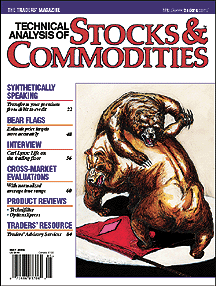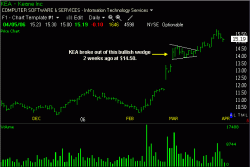 Archive for April, 2006
Archive for April, 2006
CyberTrader Pro
April 25, 2006 at 6:31 pm
Bar none, it is the most important thing when it actually comes down to placing and monitoring your trades – the trading platform.
Trading is my job, and I want to be using the best tools available for my specific needs. Having said that, I’ve tried out plenty of trading platforms along the way, and the platform of choice for me is CyberTrader Pro. I’m asked frequently which broker I trade through. Here are a few reasons why I am with CyberTrader:
How Much?
April 24, 2006 at 9:45 am
Compounding money has been called the 8th Wonder of the World. It truly is amazing what can be done when you make regular incremental gains. It is no wonder then that successful active trading should include an understanding of the best ways to size positions properly according to your trading method in order to maximize profitability. I’ve known plenty of brand new investors who had just a small amount of money which they piled into one idea all at once. However, the experienced trader knows better than to do this with his entire trading account, so let’s explore this topic a little further!
#1 Advisory Service in S&C Magazine!
April 20, 2006 at 9:49 am
I just received the May 2006 issue of Technical Analysis of Stocks & Commodities magazine, and was quite happy to see The Bandit Broadcast stock newsletter topping the list as the #1 Advisory Service!

The list is on page 84 in case you pick up a copy of the magazine, but here’s a picture of the page:
If you want to see what all the buzz is about, stop by the website and sign up for your Free Trial! It’s a no-risk way to peer over our shoulder and see how we trade.
Jeff White
President, The Stock Bandit, Inc.
www.TheStockBandit.com
Check Your Rolex
April 18, 2006 at 1:36 pm
There are traders and there are investors. To me, the primary difference is the timeframe you operate on.
One of Stephen Covey’s 7 Habits of Highly Successful People is to “begin with the end in mind.” This is a key element of planning a trade (or investment), as only knowing your timeframe will allow you to accurately evaluate your position. Covey goes on to provide some great advice, which can certainly be applied to trading…
“To begin with the end in mind means to start with a clear understanding of your destination. It means to know where you’re going so that you better understand where you are now so that the steps you take are always in the right direction.”
Deciding what kind of trader you should be depends on your timeframe as much as it does your personality. What kinds of trades do you prefer to take? Have you determined which trading strategies are right for you? Buying pullbacks within an uptrend? Short selling stocks on low-volume rallies right up to resistance? Or are you a buy-and-hope hold investor looking to be the next Warren Buffett? Your timeframe is the deciding factor.
Investors will often include fundamental data in their trading strategy and execution plan, knowing that the performance of the business behind the stock they own can have an impact on how the stock moves over time. Such an impact is not usually very quick (unless it’s earnings season), and as a result, investors know that their timeframe must be long enough to allow their fundamental thesis to pan out.
I’m a trader, and to me, short-term price action is more about supply and demand than the fundamentals of a company whose stock I’m trading. Business doesn’t usually pick up or fall off overnight…it takes many weeks and months and years. My trading timeframe ranges between several hours up to a couple of weeks. This normally excludes almost any fundamental impact on the stocks, because I’m swing trading the supply and demand shifts.
So whether you’re just starting out in the market and selecting a trading style that suits your needs, or if you’re already a trader or investor who is evaluating what to do next, be sure to examine your operating timeframe. If you have long-term ideas based on company-specific data, your investment timeframe should allow your fundamental ideas to prove themselves. On the other hand, if you’re looking to compound your money quickly and eliminate as much risk as possible, then a swing trading strategy may be better for you. The most important thing is to know your timeframe before you put cash to work, because only then will you be able to fairly evaluate if your stock should be kept or sold.
Jeff White
President, The Stock Bandit, Inc.
www.TheStockBandit.com
5 Expensive Words
April 12, 2006 at 10:51 am
Rarely do they pay off, and yet we’ve all said those 5 costly words……
“just a little more room.”
Whether it’s been on the winning side of trades where I’ve tried to squeeze the last $0.50 out of a stock, or it’s a losing position that has been trying to tell me I’m wrong (those numbers are RED for a reason!), I am guilty!
Oddly enough, as cheap as it is to enter trades with commission structures so affordable, have you ever noticed just how expensive it can be to stay in a trade?
We all know the rules….
• Obey thy stop!
• Never Believe in your stock!
• Don’t let a trade become an investment!
…..yet it is so easy to break them. It’s a solitary job, and the only person to prevent you from compounding your mistakes is the one you see in the mirror.
So, be your own ally. Have a trading plan in place before you login to your account. Do your homework. Set hard stops as soon as your orders are filled, and let those safety nets keep your losses small (we all know how easy it is to blow a mental stop).
Be smart! Trading is about real money, not just flickering numbers on a screen. Be prepared and protect your capital at all costs. That guy in the mirror will hold you accountable the next time you see him!
Jeff White
President, The Stock Bandit, Inc.
www.TheStockBandit.com
Keep it Rolling
April 5, 2006 at 9:04 pm
It’s no secret that the fastest way to compound your money is to keep it working for you. For that reason, when I’m in the market, I do my best to keep my trading capital at work in stocks that are on the move. I lose patience quickly in trades that stall out, because I know there’s opportunity elsewhere I ought to be capturing. So when a stock begins to lose steam, I raise my stops aggressively so that if the trade begins to flutter, I am checked out of the stock and am free to put my money to work elsewhere.
 KEA worked for a little while, but once it slowed down I raised stops aggressively. When stocks slow down, there is opportunity elsewhere to capture.
KEA worked for a little while, but once it slowed down I raised stops aggressively. When stocks slow down, there is opportunity elsewhere to capture.Today I was stopped out of KEA (Keane Inc.), but with a gain. I highlighted this stock as a swing trading candidate in my stock newsletter 2 weeks ago with a buy point of $14.50. KEA quickly began to work, showing me a gain of 9.5% in just 8 days. I raised my stop on Sunday night, and on Monday this stock began to fizzle out. With the market on the verge of a breakout, I was in no mood to stick with this trade, knowing that there would be a number of other opportunities I could catch if KEA was going to stall out. Today, I was stopped out at the close.
Getting stopped out doesn’t bother me, for a few reasons:
1) I booked a winning trade of 4.5% in 2 weeks. Not stellar, but not bad either.
2) I like to keep my money rotating into new stocks with potential, rather than sticking with a stock that is no longer on the move in my direction.
3) I now have more cash on hand to put into new setups which I highlighted tonight in the Member Area.
Force your trades to continue showing you why you should keep them on your screen. When your trading capital is at work, expect a lot from it. Whenever your positions stop producing profits for you, it’s time to move on to something else that will.
By keeping your money rolling from one good trade to the next, you’ll be able to rack up returns that would make the buy-and-hold crowd blush.
Jeff White
President, The Stock Bandit, Inc.
www.TheStockBandit.com
Masters Trivia Results
April 4, 2006 at 12:28 pm
The results are in, and today’s t-shirt for the Masters Trivia has been claimed! Congratulations to Jason T. of Scottsdale, AZ on winning today’s trivia! He’s in the right place to love golf, and his 3-part answer certainly demonstrated some Masters expertise. Jason, nice work – your t-shirt is on its way!
The correct answers were:
1) Holes 11, 12, and 13 make up Amen Corner at Augusta National.
2) Ben Hogan shot 66 at age 54 to post the lowest round by a senior back in 1967.
3) Nick Price and Greg Norman share the course record of 63 at Augusta National.
Thanks to all who participated in today’s trivia. Those of you who answered correctly but weren’t the first to do so, take heart! Just like missing out on a good trade, there will be more T-Shirt Trivia opportunities ahead! Thanks again for participating and for reading TheStockBandit.net!
See you back here tomorrow for more market chatter and trader talk!
Remember to subscribe to this feed so you won’t ever miss a post!

Jeff White
President, The Stock Bandit, Inc.
www.TheStockBandit.com







